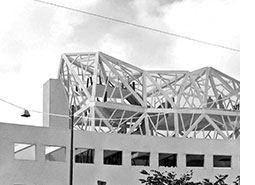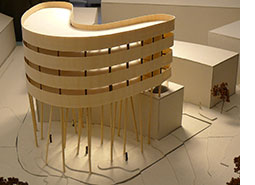
Urban transformation in timber
AUTUMN 2015
Course description:
Sustainable buildings must be designed for long life cycles. They must have a high and durable architectural and technical quality and they must be adaptable to varied use over time. They must combine generality in room forms with possibilities for flexible partitioning and furnishing. This requires tight coordination of constructions, building envelopes and the systems for water supply, sewage, heating and ventilation.
The main aim of the course is to develop strategies for transformations in dense, urban locations using timber as a main material. The design task is a medium-sized project combining new buildings, add-ons and refurbishment. The project shall contain a mixture of dwellings and other functions typical of urban areas. Adaptability to alternate future use shall be explored and documented.
The formability of timber components shall be utilized in studies of how contrasting geometries may interact in architectural design. The solutions shall be developed to a high degree of detail. Selected site: Maridalsveien 10.
Tutors: Marius Nygaard, Catherine Sunter, Lars Hamran
Students: Ingri Heggebø, Sunniva Nordli Helseth, Johanne Finanger Killi, Ida Helene Holm Mjelde, Pål Andreas Løyning, Jan Kazimierz Godzimirski, Maria Årthun, Sigurd Aune Hellem, Anja Lauvli Schley, Michelle Schneider, Synnøve Solberg, João Carlos da Silva Mendes, Léa Guillot, Joana Alexandra Agra Graça, Roel Hofstra
External examiners: Christopher Adams, partner in div.A architects
Selected student projects:  THE BOTANICAL LEARNING CENTRE - by Roel Hofstra
THE BOTANICAL LEARNING CENTRE - by Roel Hofstra
A new wooden greenhouse is added onto the existing building. The greenhouse is constructed as an irregular skeleton. The floors are made of cross-laminated timber (CLT), carried by the existing concrete structure. The triangulated construction system adapts easily to different shapes, enabling the structure to respond to the building below and to its surroundings.
DOWNLOAD PROJECT DESCRIPTION HERE (pdf) HOSTEL - by Sunniva Helseth, Johanne Killi and Anja L Schley
HOSTEL - by Sunniva Helseth, Johanne Killi and Anja L Schley
The project responds to the historic and environmental conditions of the site. The hostel offers 168 beds and common functions that bring activity to the area. The main structural system is cross laminated timber walls and floor slabs together with glulam beams. The shear stiffness of the curved CLT walls stabalise the structure.
DOWNLOAD PROJECT DESCRIPTION HERE (pdf) FLOATING WOODEN OFFICE - by Ingri Heggebø and Synnøve Solberg
FLOATING WOODEN OFFICE - by Ingri Heggebø and Synnøve Solberg
The new building is elevated 15 meters off the ground and follows the curved outlines of the site, hovering above the existing building. The primary construction consists of a system of glulam colums and beams. The building rests on 22 steel columns. At least two columns support each radial beam in the floor construction.
DOWNLOAD PROJECT DESCRIPTION HERE (pdf)
To order high resolution of project descriptions:
The above project descriptions have been reduced in size for ease of upload and accessibility. This may in some cases have affected the overall quality and resolution of images or drawings. You can request high resolution copies of the original documents by contacting the WBB using the email wbb@aho.no. Please stipulate the title of desired project and intended purpose and/or use of project material.